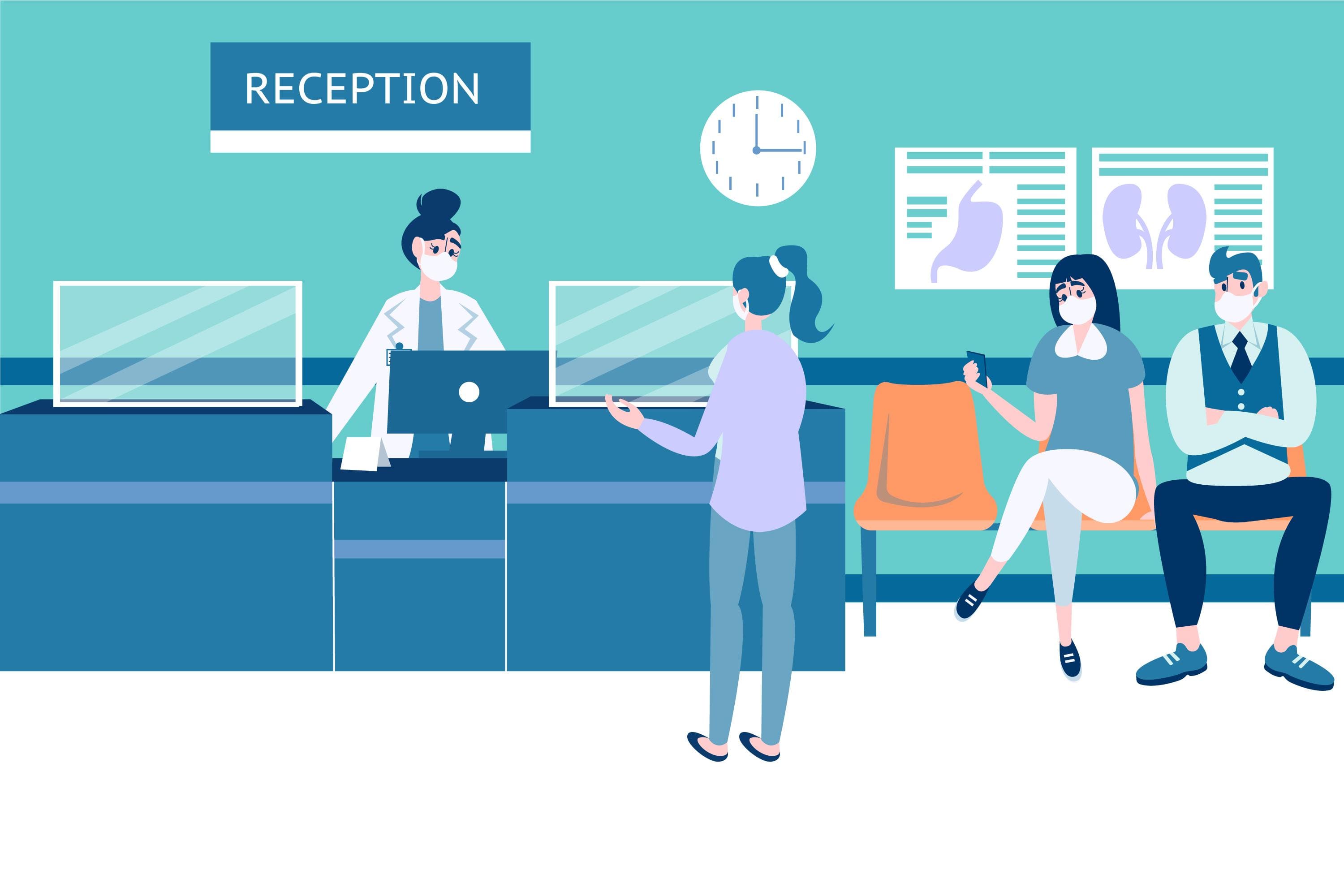How Actual and Perceived Waiting Time Affects Patient Satisfaction?
The healthcare industry revolves around the patients it sees. So, much like in any other industry where customer satisfaction matters a lot, in the medical sector, it is patient satisfaction, which stands absolutely crucial.
Patient satisfaction in the healthcare industry is not only the primary thing to be considered but also stands as a crucial metric, on which, depends the overall quality of the healthcare service. However, the latest survey reveals that around 67% of the patients in the US are dissatisfied with their provider or the healthcare service they receive there.

What influences patient satisfaction?
Patient satisfaction needs to be upheld by practices at any cost. However, not all patients are happy with the services they receive from their healthcare providers. According to recent reports, around 59% of the patients belonging to the GenY group, are looking to switch their providers who are equipped with better online access. Therefore, online systems and software are really something that the practices need to embrace to keep pace with the digital age that we are living in now. Besides, it is important to note that patients simply love the digital ways. If you are also wondering about the factors that influence patient satisfaction, then here they are:
Patient waiting time
The wait time of the patients stands crucial in the formation of patient satisfaction. Wait time can be identified as the time that the patients need to wait before they are tested for their disease or diagnosed by a doctor/physician. Over 84% of the patients believe that the wait time they experience is really important to the overall experience in a practice. The patient waiting time, therefore, plays an important role in influencing the patient satisfaction rate.
Security of the processes
Though the digital ways are essential for the healthcare practices of now, it is also important that they embrace secure and efficient providers to implement the digital facilities. Around 78% of the patients are more likely to share their own information and medical histories with the doctors through a secure online portal. This can be possible only via trusted medical office software providers like GrowPractice, which extends fast, secure, and easy-to-use medical office software solutions to revamp your medical office.
The behavior of the medical staff/workers
Along with the tools that are there in the medical offices of the practices, it is also important at the same time that the medical practices have workers who are experienced and well-mannered. The behavior of the medical workers towards their patients plays an important role in overall patient satisfaction.
Patient engagement
Patient engagement is something that the practices simply cannot miss out on. Engaged patients are always engaged with their health and their provider and always focus on looking up for something relevant. Such patients are always curious to learn what more they can have for services and if the practices manage to extend the best of services to them, as per their expectations, then it definitely boosts the overall customer satisfaction.
Transparency of the services
Transparency is always required regardless of the nature of the business to ensure the growth of the business. The same goes as far as the healthcare industry is concerned. In the medical sector, it is the patients to whom an adequate amount of transparency should be extended by the providers. The transparency in the costs of the healthcare services is regarded by the patients are something very important, according to the recent reports that say over 65% of the patients are of the same opinion.
According to the Maximizing Patient Access and Scheduling, An MGMA Research & Analysis Report, '43.4% of the patients rarely or never know about the length of their appointment'. This is a major concern for the patients on which depends their overall satisfaction of them. Therefore, transparency when it comes to patient wait times is also something that the practices should arrange without further delay.
Followup outside the appointment time
The patient appointments and the diagnosis process shall certainly be of utmost importance but due follow-up after the appointment and even in erratic time schedules are equally important for the patients. Responsive to the follow-up questions and via email or phone is deemed as something critical by around 58% of the Gen Xers, Gen Zers, and the millennials. It is the same thing with the aged patients too, where an overwhelming majority of 63% of them want a proper follow-up to continue even outside the appointment hours
Though with the digitalization the patients today are enjoying the best healthcare services that could have been possible, patient waiting time is a persistent issue to date, which has only waned a little. The wait time has been declared by around 43% of the patients to be the most frustrating part that they have to undergo while visiting a doctor.
However, in the case of wait times what is true and challenging is that the wait time for the patients is subjective and not objective. Therefore, unlike the security concerns, checkup and diagnosis, booking of the appointment and their likes are objective, the patient waiting time is purely subjective and that differs from one patient to another. To understand this in detail, it is better to check out the actual patient waiting time and the perceived patient waiting time because there lies all the difference.
What is the actual patient waiting time?
Patient waiting time, in reality, is the total time (in minutes/hours) that the patients need to wait before they finally manage to finish a particular test or conclude with meeting a doctor. This is the patient wait time that is a fact for the patients and the general mass alike.
What is perceived patient waiting time?
We are prone to expect something from beforehand. Though this expectation of us might or might not be turned to be the reality afterward, we judge a certain thing out of our expectation too. The same thing happens with the wait times, where the patients expect a certain amount of time that they need to wait while in reality, they need to wait for either less or more than what they had earlier expected. Therefore, the patients judge the length of their wait times and might either be satisfied or dissatisfied with the actual waiting time they need to endure. Thus, the perceived waiting time of the patients might simply be described as what the patients think or expect their wait times will be.
The importance of the perceived patient wait time
The expectation of something is inherently a characteristic of humans, who are either overjoyed or disappointed with the ultimate result of the event. Similarly, the perceived wait time is a crucial idea that develops in a patient's mind before they actually face the wait time at the practice. What's more important here is that the patients tally the actual wait time to the perceived waiting time and then draw their own conclusion as to how satisfactory the wait time was. This part of the patient experience then influences the ultimate patient satisfaction.
We might think that the perceived patient wait time is just another idea building deep inside the patients, but that perceived waiting time is directly related to patient satisfaction, as a matter of fact.
30% of the patients have reportedly walked out of their appointments due to the long waiting hours that they had to face at their respective practices. This is a direct outcome of the perceived wait time, which was clearly way lesser than the actual waiting time that they faced, thereby leading them to the brink of their frustrations, so much so that they left their providers.
The perceived patient wait time can lead to some severe impacts indeed, which includes leaving the practice altogether, thereby switching their providers. Perceived wait times, therefore, can adversely affect the patients as well as their practices. On one hand, the perceived waiting times of the patients can lead to delayed treatment or no treatment at all along with hampering the patient's other appointments, while on the other it leads to a severe loss in the practice reputation and its revenues.
Actual and the perceived patient waiting times and the patient satisfaction!
The patient waiting time in the waiting room should ideally be less than 10 minutes while the waiting time of the patients from the exam room to the doctor's visit should be ideally below the 20 minutes-mark. Such waiting times are materialized for the patients, shall be extremely beneficial for the clinics and practices. However, reports say that most of the patient's appointments exceed the ideal waiting time mark and are, therefore, considered to be long waits by the patients. This leads to a wide scale of patient dissatisfaction.
In reality, both the actual and the perceived patient waiting times influence the overall patient satisfaction. Therefore, if the actual wait time is lessened and/or the perceived waiting time of the patients is increased, it will definitely boost patient satisfaction. Now, though the reduction of the actual waiting time is possible, it is a challenging task indeed to drag down the perceived waiting time of the patients. However, if you truly need to reduce the perceived patient waiting time, then here are some tips to do so.
Easy hacks to relax the perceived patient waiting time?
The patient's perception of the wait time certainly comes fixed on most of the occasions but as we are humans, our perception often varies on our emotions. In quite the same way, the perceived patient waiting time varies on the patient experiences. Therefore, we have researched on the patient-perceived wait time and have concluded with some easy hacks that will help the practices broaden the perceived waiting time of the patients, thereby increasing patient satisfaction. Check them all out here below:
Booking the patient appointments fast
The patient appointment is the very first interaction that the patients have with their providers and thus, plays a crucial role in forming the overall patient experience. These appointments, which were earlier done in a face-to-face meet or via phone calls, can now be easily done, even in erratic time schedules, online. Here's where GrowPractice comes to the scene. One of the most trusted and secure medical office software providers, GrowPractice helps the practices to book their patient appointments fast and without worries.
Among all the patients who book their appointments, a considerable number of patients actually need to book their appointments outside of business hours. This has been a major challenge earlier when digitalization was a faraway dream. However, with the emergence of the digital age and the digital providers, booking patient appointments can be smooth and effortless with the effective software from GrowPractice that enables the practices to book their appointments anytime. If the patient's appointments are booked faster, then that will be an achievement for the practices themselves, and will elevate the patients indeed!
Extending a fast patient check-in and intake process
The patient check-in and intake process have always been ill-reputed as some of the most time-consuming tasks that the patients need to bear. Besides, the check-in and intake process of the patients is always a point where security is the prime focus because during this step the practices need to go through sensitive patient data governed by HIPAA. However, this will be more than a breeze with the birth of GrowPractice, which brings HIPAA-compliant, online patient check-in and intake process for the practices that will immediately boost patient satisfaction. Fast patient check-in and intake can delight the patient so much so that he/she end up worrying no more about their waiting time.
Staying transparent
Transparency is a virtue that all wish but only some ultimately receive from their providers. Therefore, if your practice is transparent with the wait times and the cost of the overall healthcare services, then that will be an added bonus for the provider. This is because transparency in healthcare is regarded by a vast majority of the patients as critical to their overall satisfaction.
Installing a digital display
Installing a digital display can certainly play a huge role in setting the correct expectation for the patients via current and updated information for them on behalf of the practices. A digital display with the updated patient waiting time can thus be a remarkable idea for the practices to check the perceived waiting time and delight the patients!
Engaging the patients well
Patient engagement, as we have seen earlier, always proves to be a deciding factor when it comes to the summing of the overall patient experience and in customer satisfaction surveys. Booking fast appointments, staying close to the patients while in wait, having the patients' book, change/cancel their own appointments, extending diverse activities while the patients are waiting are some of the easy tricks to increase engagement.
Staying by the patients
While in wait the patient might have to face diverse situations where they might be needing assistance from the healthcare staff. Here, if the medical workers look after their patients, then that would certainly help the patients a lot in real-time. Furthermore, the assistance that the practice and its workers will provide the patients would also help them understand that their provider truly cares for them. Staying by the patients is thus one of the prominent ways to boost patient satisfaction.
Revamping the waiting room ambiance
The last but not least effective way to boost the patient's perceived wait time is to boost the waiting room ambiance. A lively, cheerful waiting room with adequate staffing to guide the patients and a digital display to inform the expected wait times for the patients is always a boon for the practices. On the other hand, a depressive waiting room definitely takes the patient's moods down and annoys them in case of delays. So, right from the color to the decoration, and the facilities extended to the patients, the practices should not shy away from rebuilding their waiting room ambiance if it is not up to the mark for the patients.
Reduce the time in the medical office waiting room effortlessly and boost patient satisfaction!
It is really challenging to fix this insoluble knot between the perceived and the actual patient waiting time, but all that the practice owners and managers shall aim at is the reduction of the patient wait times. This is now possible with the emergence of GrowPractice, which brings the best and the most effective medical office software, patient and practice management tools, and solutions to boost patient satisfaction. With its improved medical office software, Growpractice has already been able to save over 75% of the staff time for the practices which lead to over 500 hours being saved for each provider.
Here's something else that Growpractice will bring to your practice:
Along with all these benefits, the practices of today will also be getting an accurate billing process and much more with GrowPractice. The reliable medical office software provider, which is currently trusted by numerous US Federal Government agencies too, have already proven to be a huge benefit for all the practices that use the tailor-made solutions by GrowPractice. So, why not contact them now?



